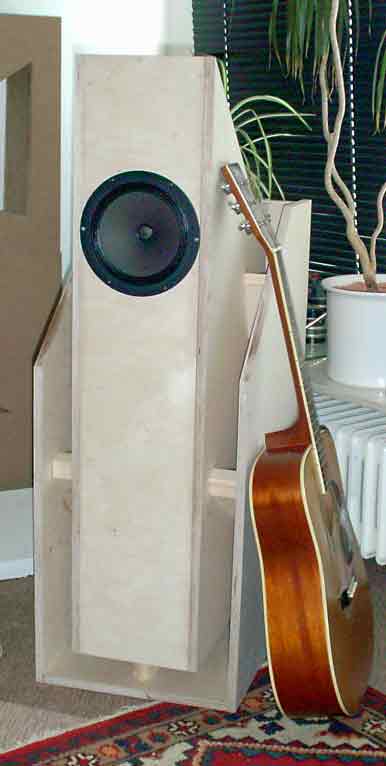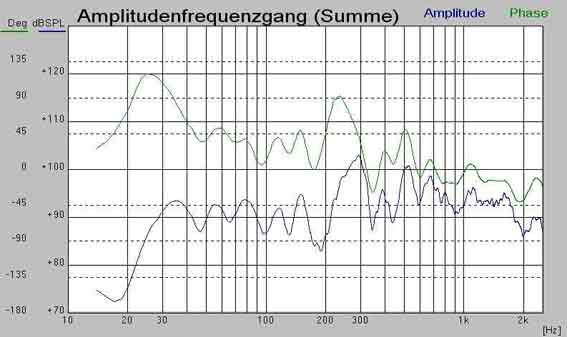
Many posts ago, I announced that I would be featuring some input by Horst Möller, of the HM-Moreart website. Horst is the creator of a wide range of backloaded horn designs, which has earned him both fans and critics. He certainly has a respectable career, with several of his designs featured in the leading German DIY audio magazines and others interesting enough to manufacturer Visaton to test in their own facilities. The published designs are already somewhat older, but definitely worth checking out. One of them is for Jordan 92-sized drivers, the other for Manger or Seas coaxial-sized drivers. They can be used for other drivers, like perhaps Tang Band coaxials or Markaudio fullrange drivers. A range of Fostex fullrangers and whatever you can think will probably also work. Especially take note of the very extended range down below out of these modest driver sizes. Obviously, Horst was already a capable horn designer at the time.
Horst prepared a piece of text for me, about the use of different materials to construct horns from. Horst advocates the use of soft fiberboard, to make enclosures with excellent internal damping. This is a known use of material for horns and I used it myself in the bass horn described here. I asked Horst to write about it, because he is an experienced and accomplished designer and is a very passionate advocate of this material. A new thing he put forward, was that the material dampens most sound above 200 Hz, which ensures that few higher frequencies
travel down the horn. This creates a stronger crossover between the midrange (from the driver) and the bass (from the horn). Horst was pretty quick to deliver the text, but I lost it in a computer crash. Busy times started around that time for me, so I never really tried to resolve this. To my shame, I must point out. The basic points of the text delivered Horst are stated in this part of his website.
But Horst has done more than design relatively standard backloaded horns with soft fiberboard. Since the earlier published designs, he has started to use double driver configurations, dual horns, different pathlengths to achieve smooth response in small volumes, bipole/dipole configurations and creative space-using concepts (like horns incorporated in seats). Very neat stuff. You understand why he has fans by now. On the other hand, Horst releases half complete plans for "normal" DIY-ers and only supplies fully detailed copies in print and at payment. Some of his designs look less like a horn than most DIY-ers would expect and they clearly don't trust on the good results by looking at the pictures and diagrams. And, it must be said, discussions with Horst about his designs can carry on and on and on, with neither side moving much to either side. These are some of the possible reasons for criticism. Fortunately, this blog has an open and understanding mind for any possible position.
Some months ago, Horst released the first sketches of his latest design, which he calls the RDH20, or Rahmendopplhorn (double frame horn) for 20cm/8" drivers. Typically, the half (in)complete drawings were unclear to many and the predicted response was considered overly optimistic. Some discussion followed, but interest stayed low. I have no doubt that Horst was very disappointed. The past few weeks, looking for new copy and feeling like some modelbuilding, I considered building a Sketchup model of the RDH20. This could help visualize the horn. I just checked Horst's website and found that he now has pictures and measurements of the real thing online. It looks VERY exciting and, perhaps more importantly, VERY clear now, so I decided to fix the deleted text fiasco by publishing this post, about this very innovative design.
Some things to note about this design: There is a forward-firing and rear-firing driver. Depending on choices of the builder, the rear driver can be a woofer or a second fullrange driver. In principle, this design can be a dipole or bipole backloaded horn. The two drivers drive two different horns, of different length and expansion. The idea is that the horns have different peaks and dips and fill in each other's weak points. This principle was known before and is related to, for instance, tapped horns. The inside of the horn is largely made of soft fiberboard, to reduce enclosure sound. The inner horn rests on the outer section via a panel of soft fiberboard, which decouples it. Also notice how the horn mouth is wrapped around the entire enclosure. It is relatively large, yet the enclosure the driver sees is relatively small. Finally, I think it is a beatifully proportioned horn, which draws much less attention to itself than some of Horst's
other designs.
To his credit, and downfall, of most of his designs. He is criticized for strange and peaky/dippy response graphs, but I think they mostly show how tough it is to measure a smooth response in a room. He offers several measurements, from several drivers, measured in several positions. At the very least, the horn does bass. At best, it has response below 30 Hz. Also, he shows how the horns seems to dominate the response, not so much the driver parameters. This is something that people like Klinger also stated and Horst's measurements seem to support his.

On of the great things about Horst Möller, is his continuing drive to create, try, learn and improve. I expect the RDH20 to be just one step along the way and I am curious to see where he will go next.
2 comments:
I just noticed, this was the 50th post on this blog! Yeah!
In retrospect, this is more of a labyrinth then a horn. submitted data supports this finding. It will find favor to those wishing something with cathedral architecture. If it was for me to test, I would likely match it with tube power, on a three way arrangement. Electrical specifications are not included, so I would default to 175 Hz 12 Db Butterworth crossover, as the base line for testing. No provision is given for fill to damp the driver. I suggest 18 ounces to start to determine FS and FB3. At that point, consider relocation of the driver in the tube, based on group delay analysis. It's just a thought....
Post a Comment